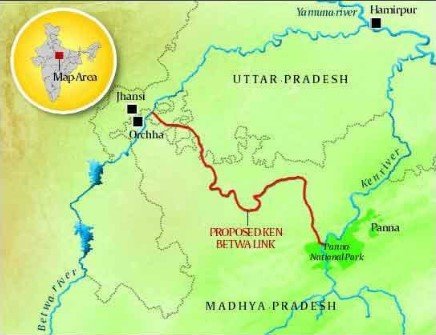
Ken-Betwa River Project Approved; 72 Sq Km Of Tiger Reserve To Be Sub-Merged
20 March 2017 11:50 AM GMT
The National Board for Wildlife (NBWL) has approved the project to interlink the Ken and Betwa Rivers, which raises concerns about the submergence of significant tiger and vulture habitats.
The Ken-Betwa link project is one of the 30 Inter-Linking of River (ILR) projects, envisaged by the Centre. The project received clearance from the Supreme Court following the tripartite Memorandum of Understanding (MoU) including Madhya Pradesh, Uttar Pradesh and the Centre.
Source: The Indian Express
After approximately 40 years since its conception, the Ken-Betwa project is the first in India’s ambitious plan to interlink its major rivers. This involves the development of a dam on River Ken, which is a major river in the Bundelkhand region of Madhya Pradesh; to transfer “surplus” water to Betwa basin of Uttar Pradesh.
Key Features
Some of the key features of the Rs 9,393-crore project include the 231.45-kilometer long canal along with a series of barrages and dams that will be built to facilitate this transfer of about 591 cubic metres of water from surplus areas to deficit areas. The project further comprises of two powerhouses of 2×30 Mega Watt and 3×6 Mega Watt each, and two tunnels of 1.9 km long at the upper level and 1.1 km long tunnel at the lower level.
Source: travelkhana
Benefits
The project is cited to irrigate a total of 6.35 lakh hectares of land, out of which, 3.69 lakh hectares of area is in Madhya Pradesh’s Chattarpur, Tikamgarh and Panna districts, while the remaining 2.65 lakh hectares of area is in Uttar Pradesh’s Mahoba, Banda and Jhansi districts.
Additionally, the project is expected to provide 49 million cubic metres of drinking water to about 1.34 million people in the two states. The project is further expected to generate 78 Mega Watt of hydropower electricity.
Additional objectives of the project include controlling floods, navigation, fisheries, salinity, drought mitigation and reducing pollution.
Drawbacks
The dams built in Makodia and Dhaudhan are main elements of the project. The project will result in submergence of 5,258 hectares of forestland, including 4,141 hectares of Panna Tiger Reserve. This means that about 7.6% of the total core forest area of the Reserve will be submerged which is pivotal to the survival of these wildcat species. Moreover, the project will cause displacement of over 1,500 families in 10 villages.
Reportedly, the total tiger population in the Reserve is 39, out of which, 13 are males, 12 are females, and 14 are cubs.
Source: ndtvimg
An advisory member of Madhya Pradesh’s wildlife board, RanjiSingh, claims that the centre of the forest park will be bifurcated, and the submergence will affect the connectivity and movement of all animals, including their prey. He also explains that it will deteriorate the quality of the habitat, as the submerged area is low-lying and close to the river containing moisture, which supports the grass growth – a major food source for herbivores. These animals include chital, nilgai, wild boar and four-horned antelope, out of which chital is a primary food source species for the tiger. According to RanjiSingh, the project will not only negatively impact Panna Tiger Reserve but also the Ken Gharial Sanctuary.
The cliffs near the Ken River are important nesting grounds for various species of vultures, including critically endangered species of long-billed and white-back vultures. However, approximately 60% of the vulture nesting area would be submerged as a result of this project, which could negatively impact these birds in the area.
Source: wildabouttravel
Plans for Improvement
The government has claimed to support 779 households living within the Tiger Reserve to be rehabilitated under a voluntary relocation plan who choose to leave the Reserve to conserve tigers, with Rs. 10 lakh, as the relief. Rs 334 crore has been allocated for the relocation plan, as per national and state guidelines.
To further compensate for the direct loss of the Tiger Habitat, Nauradehi, Rani Durgavati and Ranipur wildlife sanctuaries will be incorporated with the Panna Tiger Reserve. The dam reservoir area will be retained as core tiger reserve with reduced activities.
Fishing will not be permitted at the dam site, and no further mining leases will be allowed across the tiger dispersal routes.
The National Tiger Conservation Authority (NTCA) will pursue the landscape plan for the area in collaboration with the Wildlife Institute of India (WII) and state forest departments
Finally, the project aims to create an additional irrigation potential of 35 million hectares and further generation of 34,000 MegaWatt of power.
 All section
All section

















